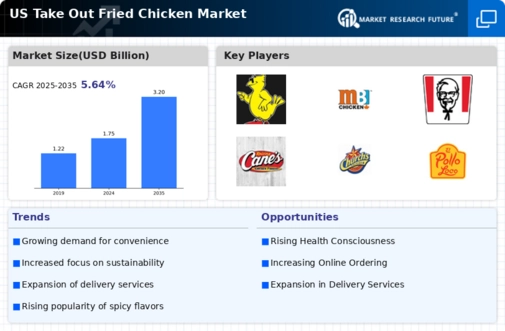Convenience and Accessibility
The take out-fried-chicken market benefits from the increasing demand for convenience and accessibility among consumers. Busy lifestyles have led to a surge in the preference for quick meal options, particularly in urban areas. According to recent data, approximately 60% of consumers in the US prioritize convenience when choosing food options. This trend is reflected in the growth of takeout services, which have expanded significantly in recent years. The rise of mobile applications and online ordering platforms has further facilitated access to fried chicken, allowing customers to place orders with ease. As a result, restaurants and chains that offer efficient takeout services are likely to thrive in this competitive landscape, driving growth in the take out-fried-chicken market.
Flavor Innovation and Variety
Flavor innovation plays a crucial role in attracting consumers to the take out-fried-chicken market. With an increasing number of options available, customers are seeking unique and diverse flavor profiles that cater to their evolving tastes. Recent surveys indicate that nearly 70% of consumers are willing to try new flavors, which encourages restaurants to experiment with different seasonings and cooking techniques. This trend not only enhances customer satisfaction but also fosters brand loyalty. Additionally, the introduction of limited-time offerings and seasonal flavors can create a sense of urgency, prompting consumers to make purchases. As a result, the emphasis on flavor innovation is likely to be a key driver in the growth of the take out-fried-chicken market.
Rising Demand for Comfort Food
The take out-fried-chicken market is experiencing a notable increase in demand for comfort food, as consumers seek familiar and satisfying meal options. This trend is particularly pronounced during times of economic uncertainty, where individuals often gravitate towards nostalgic food choices that evoke feelings of warmth and security. Data suggests that comfort food sales have risen by approximately 15% in recent years, with fried chicken being a prominent choice. The emotional connection associated with comfort food can lead to repeat purchases, as consumers often turn to their favorite meals for solace. Consequently, the growing preference for comfort food is likely to bolster the take out-fried-chicken market, as restaurants adapt their menus to meet this demand.
Economic Factors and Disposable Income
Economic conditions play a significant role in shaping consumer spending habits within the take out-fried-chicken market. As disposable income levels fluctuate, consumers may adjust their dining choices accordingly. In recent years, a steady increase in disposable income has been observed, leading to greater expenditure on dining out and takeout options. Data indicates that households with higher disposable income are more likely to indulge in takeout meals, including fried chicken. This trend suggests that as the economy continues to improve, the take out-fried-chicken market may experience further growth. However, it is essential to monitor economic indicators closely, as any downturn could impact consumer spending and, consequently, the market's performance.
Influence of Social Media and Food Trends
The impact of social media on consumer behavior is increasingly evident in the take out-fried-chicken market. Platforms such as Instagram and TikTok have become vital for food marketing, with visually appealing content driving consumer interest. Approximately 50% of consumers report that social media influences their dining choices, particularly when it comes to trying new foods. Viral food trends can create a surge in demand for specific items, prompting restaurants to capitalize on these trends by offering unique fried chicken dishes. This dynamic relationship between social media and food trends not only enhances brand visibility but also encourages innovation within the take out-fried-chicken market, as businesses strive to remain relevant in a fast-paced digital landscape.






















Leave a Comment